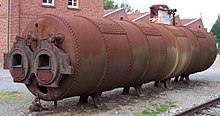Physical plant


Physical plant, mechanical plant or industrial plant (and where context is given, often just plant) refers to the necessary infrastructure used in operation and maintenance of a given facility. The operation of these facilities, or the department of an organization which does so, is called "plant operations" or facility management. Industrial plant should not be confused with "manufacturing plant" in the sense of "a factory".
HVAC
HVAC plant usually includes air conditioning (both heating and cooling systems and ventilation) and other mechanical systems. It often also includes the maintenance of other systems, such as plumbing and lighting. The facility itself may be an office building, a school campus, military base, apartment complex, or the like.
Electric Loads
Synchronized Loads
Phase Voltage Unbalance and AC Motors
A Voltage Unbalance is also called a Phase Imbalance. Some motor manufacturers require less than 5% current unbalance. In some 800 HP motors in 1,500 ton chillers the digital chillers controls stop the motor upon a 2% Voltage Unbalance.[1],[2] Electric motors tend to trip manual overload safety relays with +4% Voltage Unbalance. The digital controls on modern Air compressors can be set to automatically stop after a 2% Voltage Unbalance[3]. The compressors are to remain stopped until after clean electrical power is restored for a minimum time, say 36 seconds; with the each additional compressor staged at 6 second or longer intervals. By automatically stopping upon low voltage and voltage unbalance, one avoids the unwanted tripping of the overload relays, which require a person to manually reset. It also prevents the digital controls from restarting all of the air compressors at the same exact time, which can trip 1,200 amp main breakers.[4][5] After market digital programmable three-phase line voltage monitor controllers are available.[6]
Dialysis Units
Synchronized Loads such as a set of 15 individual dialysis units with 115 VAC 12 amp loads operating with digital controllers had tripped the 150 Amp main breaker. The digital controllers switch the heaters ON and OFF at 20 Hz, so that the heater effectively operates at 0%, 5%, 10%, 15%, etc. However, when there is a blink on the electrical power grid, then all 15 units synchronize and can trip OFF the power to all 15 units.
Broadcast engineering
In broadcast engineering, the term transmitter plant is the part of the physical plant associated with the transmitter and its controls and inputs, the studio/transmitter link (if the radio studio is off-site),[7] the radio antenna and radomes, feedline and desiccation/nitrogen system, broadcast tower and building, tower lighting, generator, and air conditioning. These are often monitored by an automatic transmission system, which reports conditions via telemetry (transmitter/studio link).[citation needed]
See also
- Activity relationship chart
- Building information modeling
- Computerized maintenance management system
- Property maintenance
- 1:5:200, an engineering rule of thumb.
- Property management
References
- ^ ABB | Unbalanced voltage supply, The damaging effects on three phase induction motors and rectifiers | An imbalance greater than 2% is unacceptable
- ^ Pacific Gas & Electric, PG&E | Voltage Unbalance and Motors
- ^ Florida Power & Light Company | Electric Service Standards | Page 3
- ^ EC&M | phase-motor-voltage-unbalance
- ^ ACHR News | Three-Phase Motor Voltage Unbalance
- ^ https://www.icmcontrols.com/productdetails/ICM450 ICM | Three Phase Monitor, Motor Protection
- ^ http://www.richsamuels.com/nbcmm/wmaq/early_wmaq/elmhurst_antenna_1928.html
